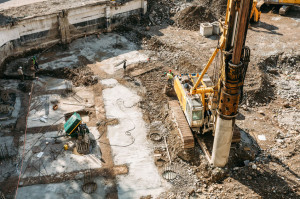 Seismic retrofitting is a critical process aimed at strengthening existing buildings to withstand the destructive forces of earthquakes. As seismic activity continues to pose a threat to communities around the world, retrofitting existing structures is essential for mitigating risks and safeguarding lives and property. In this comprehensive guide, we will explore the importance of seismic retrofitting, the methods and techniques involved, and the role of engineering firms like McNeil Engineering in protecting buildings and lives from seismic hazards.
Seismic retrofitting is a critical process aimed at strengthening existing buildings to withstand the destructive forces of earthquakes. As seismic activity continues to pose a threat to communities around the world, retrofitting existing structures is essential for mitigating risks and safeguarding lives and property. In this comprehensive guide, we will explore the importance of seismic retrofitting, the methods and techniques involved, and the role of engineering firms like McNeil Engineering in protecting buildings and lives from seismic hazards.1. Understanding seismic hazards:
Earthquakes, caused by the sudden release of energy along fault lines, can result in devastating consequences for buildings and infrastructure. Seismic hazards such as ground shaking, ground rupture, and soil liquefaction can cause buildings to collapse, leading to loss of life, injury, and extensive damage to property. In earthquake-prone regions, the threat of seismic events underscores the need for proactive measures to enhance the resilience of buildings and infrastructure.
2. Importance of seismic retrofitting:
Seismic retrofitting is essential for strengthening existing buildings and reducing their vulnerability to earthquake damage. By retrofitting older structures that were built before modern seismic design standards were established, communities can improve the safety and resilience of their built environment. Retrofitting not only protects lives and property but also preserves valuable architectural heritage and reduces the economic impact of seismic events on communities.
3. Methods and techniques of seismic retrofitting:
a. Foundation strengthening: Reinforcing the foundation of a building is critical for ensuring its stability during an earthquake. Techniques such as adding steel reinforcement, installing base isolators, or underpinning the foundation can help improve its resistance to seismic forces.
b. Structural upgrades: Strengthening the structural elements of a building, such as beams, columns, and walls, is essential for enhancing its seismic performance. Methods such as adding steel braces, shear walls, or carbon fiber reinforcement can increase the building’s ability to withstand lateral forces.
c. Non-structural mitigation: Securing non-structural components, such as ceilings, partitions, and utilities, is important for minimizing hazards and preventing injury during an earthquake. Installing seismic restraints, flexible connections, and protective coatings can help mitigate the risk of non-structural damage.
4. Benefits of seismic retrofitting:
a. Enhanced safety: Seismic retrofitting improves the structural integrity of buildings, reducing the risk of collapse and minimizing the potential for injury or loss of life during earthquakes.
b. Property protection: Retrofitting protects buildings and infrastructure from damage, reducing repair costs and minimizing disruption to businesses and communities in the aftermath of seismic events.
c. Preservation of heritage: Retrofitting historic and culturally significant buildings helps preserve architectural heritage and cultural identity, ensuring that these valuable assets remain intact for future generations to enjoy.
5. The role of engineering firms in seismic retrofitting:
Engineering firms like McNeil Engineering play a vital role in the seismic retrofitting process. With expertise in civil and structural engineering, these firms provide comprehensive design services to assess, plan, and implement retrofitting projects. From conducting seismic assessments and structural analyses to designing retrofit solutions and overseeing construction, engineering firms collaborate with building owners, architects, and contractors to ensure the successful implementation of retrofitting measures.
6. Community resilience and preparedness:
Seismic retrofitting not only strengthens individual buildings but also contributes to the overall resilience of communities in earthquake-prone regions. By retrofitting critical infrastructure such as hospitals, schools, and emergency response facilities, communities can ensure that essential services remain operational following a seismic event. This enhances community preparedness and enables more effective emergency response and recovery efforts, ultimately saving lives and reducing the socio-economic impact of earthquakes.
7. Sustainable development and risk reduction:
Incorporating seismic retrofitting into urban development plans promotes sustainable growth and risk reduction. Retrofitting existing buildings reduces the need for new construction, conserving resources and minimizing environmental impact. By prioritizing resilience in building design and construction practices, communities can mitigate the long-term risks associated with seismic hazards and create safer, more sustainable built environments for future generations.
8. Public awareness and education:
Raising public awareness about the importance of seismic retrofitting is crucial for fostering a culture of preparedness and resilience. Community outreach initiatives, educational programs, and public forums can help inform residents, building owners, and policymakers about the benefits of retrofitting and the steps they can take to protect themselves and their communities from earthquake risks. By empowering individuals and communities with knowledge and resources, we can build a safer, more resilient society.
McNeil Engineering:
Ready to protect your buildings and community from seismic hazards? McNeil Engineering offers comprehensive design services, including civil engineering, structural engineering, and consulting, to help strengthen existing buildings and infrastructure against earthquakes. With a commitment to delivering timely, responsive, and economical design solutions, McNeil Engineering is your trusted partner in seismic retrofitting.
Seismic retrofitting is a critical component of disaster resilience, helping communities mitigate the risks posed by earthquakes and protect lives and property. By investing in retrofitting measures, building owners, municipalities, and communities can enhance their built environment’s safety, resilience, and sustainability. With the expertise and support of engineering firms like McNeil Engineering, we can build stronger, more resilient communities that are better prepared to withstand the challenges of seismic events.








